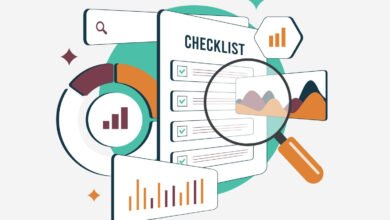Master Your Website’s Performance and SEO Metrics

▼ Summary
– Monitor website uptime and performance to prevent revenue loss and maintain search rankings by tracking speed, errors, and redirects.
– Track keyword rankings and search intent using tools to optimize visibility and focus on efforts with a return on investment.
– Use monitoring tools to track website changes like content updates and URL modifications to connect them with ranking shifts.
– Analyze lead behavior and conversions to identify sources, pipeline opportunities, and issues like broken form fields for B2B ROI.
– Monitor traffic metrics, backlinks, and brand mentions to understand visitor sources, build authority, and drive sustainable growth.
Launching your website is just the beginning; the real work lies in continuously monitoring its performance and SEO metrics to ensure sustained growth and visibility. Without diligent tracking, you risk missing critical insights that drive traffic, engagement, and conversions. By leveraging the right tools and focusing on key areas, you can transform raw data into actionable strategies that elevate your site’s authority and user experience.
Website performance and uptime form the bedrock of user satisfaction and search engine trust. Slow-loading pages or unexpected downtime can sabotage conversions, reduce engagement, and harm your rankings. While tools like PageSpeed Insights offer valuable speed data, they represent only one piece of the puzzle. A comprehensive approach includes monitoring uptime to prevent revenue loss and indexing issues, identifying server or client errors like 5xx and 4xx codes, fixing broken redirects, and ensuring internal links remain functional. Manual checks are inefficient, so automate audits with platforms such as UpTime Robot, Pingdom, or Semrush Site Audit to catch problems before they escalate.
Keyword rankings reveal how visible your content is across search engines and AI platforms. If your pages aren’t appearing for relevant queries, you’re leaving traffic and revenue on the table. Instead of tracking rankings manually, rely on specialized tools to monitor current positions, ranking fluctuations, geographic performance, and traffic potential. Look beyond surface metrics to analyze average positions, distribution patterns, volatility, trends, keyword difficulty, search intent alignment, and click-through rates. This depth of insight ensures your optimization efforts deliver measurable returns. Google Search Console, Semrush, and SE Ranking are excellent for this purpose.
Websites undergo constant updates, from content refreshes to technical adjustments, making change tracking essential. On larger sites managed by multiple teams, even minor edits can introduce errors or impact SEO. Proactive monitoring helps you track accessibility compliance, site speed, content modifications, URL changes, and redirects. By comparing before-and-after states, you can directly attribute ranking shifts to specific actions, like a service page update that catapults a keyword to the top spot. As sites scale, automation becomes non-negotiable. Consider tools like Semrush, Screaming Frog, VisualPing, Botify, or Lumar to maintain oversight.
Lead monitoring connects SEO efforts to tangible business outcomes, especially for B2B brands. Modern marketing reports highlight that websites and blogs deliver the strongest ROI, so proving value is crucial. Use lead tracking solutions to identify anonymous visitors, pinpoint pipeline opportunities, trace lead sources, and assess conversion potential. Don’t stop at arrival, analyze behavior to see which pages attract prospects, where they drop off, and whether form submissions encounter errors. Understanding the full visitor journey provides insights manual methods can’t match. LeadForensics and Formstory.io are powerful options here.
Traffic and analytics serve as the pulse of your marketing efforts, offering a clear view of visitor behavior and campaign effectiveness. Key metrics to watch include total sessions, unique visitors, pageviews, pages per session, average session duration, bounce rate, traffic sources, impressions, clicks, and click-through rate. Advanced analytics platforms allow audience segmentation, behavior tracking, and conversion goal setting. They can even highlight revenue per visitor or technical issues like crawl errors. Google Analytics, Google Search Console, Looker Studio, and Fathom Analytics are indispensable for this level of analysis.
Backlinks and brand mentions significantly influence rankings and authority. Track the total number of links, referring domains, follow versus no-follow ratios, anchor text diversity, and new or lost links. With the rise of generative engine optimization, unlinked brand mentions also matter, helping AI models associate context with your brand. Monitor mentions across forums, social media, and articles for relevance, sentiment, and volume. Consistently tracking these signals builds credibility and can drive referral traffic. Semrush, Google Alerts, and Mention simplify this process.
SSL and domain expiration might seem minor, but they directly impact site security, trust, and availability. Letting certificates or domains lapse can disrupt sales, undermine user confidence, or take your site offline entirely. Monitor SSL status, expiration dates, mixed content errors, and HTTP to HTTPS redirects. Automated alerts from tools like Red Sift Certificates, UptimeRobot, or TrackSSL help you avoid these pitfalls and maintain the credibility you’ve worked hard to build.
Establishing a robust monitoring system is fundamental to long-term SEO success. By consistently tracking these metrics, you gain the data needed to make informed, impactful improvements. Adopt the tools and strategies outlined here to keep your site healthy, competitive, and primed for growth, catching issues early, enhancing performance, and achieving sustainable results.
(Source: Search Engine Land)




